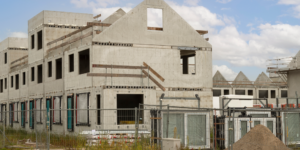
According to third-quarter 2021 data from the US Chamber of Commerce Commercial Construction Index, staffing shortages and problems with material supply chains are two of the largest hurdles currently facing contractors. These two factors combined present a dire situation for individual businesses and the US building industry as a whole.
92% of contractors reported difficulty finding skilled workers for projects, and 55% of these reported “high levels of difficulty” — a 10% jump from the second quarter. And 93% of contractors reported problems with at least one material shortage — not a shocking statistic considering lumber, steel, copper, and concrete have all seen rapid price climbs over the past 18 months.
Since March of 2020, contractors have seen delayed projects over strict health and safety protocols and material shortages. They have also seen bright spots amidst the uncertainty, such as a multi-trillion-dollar infrastructure bill signaling expansive construction, and last year’s climb of lumber prices’ bubble bursting bringing some relief and optimism for projects ahead.
But there may be some way to go before COVID-19 is firmly in the rearview mirror and the construction industry undergoes a full recovery. For trade workers, that includes difficulty finding work due to a seesaw of various other building material prices and in turn acquiring them for their projects. Chief among them, steel.
“Supply chain shortages and rising inflationary pressures are threatening to stop our economic resurgence in its tracks.”
–Neil Bradley, US Chamber of Commerce Executive Vice President and Chief Policy Officer
92% of contractors reported difficulty finding skilled workers
The skilled worker shortage has prompted 42% of contractors to report they turned down proposed projects due to insufficient staffing.
Spikes in material prices and supplier shortages can quickly lead to project delays, contract disputes, and payment problems. These issues are causing headaches for many, as 73% of contractors reported that the lack of skilled workers is impacting project deadline requirements, and 10% anticipate their revenue decreasing, up 4% from the previous quarter.
“This quarter’s Index findings demonstrate the fragility of our economy’s recovery from the COVID-19 pandemic,” said Neil Bradley, US Chamber of Commerce Executive Vice President and Chief Policy Officer. “Supply chain shortages and rising inflationary pressures are threatening to stop our economic resurgence in its tracks.”
Pricing variability, shortages, and tariffs continue to impact the industry
As previously reported, the once murky outlook of the price of lumber- peaking at an all-time high of $1,711 per thousand board feet this spring — relaxed to a “new normal” between $800–$900.
But there is more to construction than wood. In the Q3 report from the US Chamber of Commerce, steel tops lumber in the most reported shortages contractors encounter, at 34% to lumber’s 31%. The previous quarter, lumber took the top spot with 33% while steel sat at 29%.
Steel’s drop in supply has led to a price surge. Once between $500–$800 before the pandemic, steel is now trading for $1,900 per metric ton according to HRC Steel Futures. This all-time high figure, along with existing tariffs on imported steel, has caused numerous delays and frustrations for steel-intensive industrial projects and more.
On center stage is the tariff feud between the US and Europe, whose governments remain gridlocked on taxing the material being imported between them.
President Biden remains ambivalent on reversing the 25% tax on European steel imports implemented by then-President Trump three years ago, as the tariffs are very popular with a majority of steel companies and the unions for their workers in the Midwest and Northeast regions of the U.S.
While Commerce Secretary Gina Raimondo signaled in April 2021 that the taxes may continue — claiming that tariffs “helped save American jobs in the steel and aluminum industries” — many critics believe they are a driving factor for the disruption of the supply chain.
Charles Bernard, President of Pennsylvania-based Eagle Metals, reported that orders for most types of stainless steel now take up to six months to arrive at their headquarters, compared to a pre-pandemic five-week turnaround.
Although many have stated that the 2018 Trump-issued tariffs on Canadian and Mexican steel have been lifted, those on European building materials remain.
The Biden administration continued tense discussions on the removal of tariffs with European leaders, who claim that the issue is a shared one concerning the issue of global steel-producing behemoth China’s increased production.
One solution reportedly floating inside the White House’s considerations since earlier this month is the implementation of a “tariff-rate quota,” according to reporting from Bloomberg who spoke to anonymous sources familiar with the discussions.
According to various press releases regarding the implementation of other tariff-rate quotas on various goods from the Office of the US Trade Representative’s website, these measures permit nations to trade indicated amounts of an item to different countries at a lower obligation rate, yet subject all imports of the item over an established price threshold to higher ones.
While there has been no formal proposal sent to the EU, this remains the most notable potential move on eliminating tariffs on steel and easing the burden of contractors nationwide.